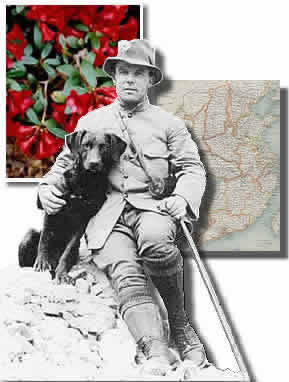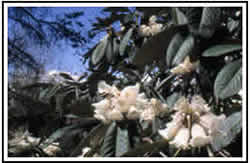|
Home > The
Explorers > George Forrest
George Forrest (1873 - 1932)

George Forrest was a remarkably productive plant collector and explorer,
who made seven major expeditions and introduced hundreds of species
to western cultivation, but we are denied his own accounting of how
this was done, as he never found the time to write his story down.
He had always said that he intended to save that task for his retirement,
but unfortunately, that was not to be.
Born in Falkirk, Scotland on March 13th 1873, George Forrest
was educated at Kilmarnock Academy and was later Apprenticed to a local
chemist, where he learned about the medicinal properties and uses of
many different plants, and also learned about the drying and preserving
of herbarium specimens.
With a modest inheritance he was able to seek adventure further afield,
so he headed for Australia at the height of the gold rush of 1891.
He remained in Australia for over ten years, panning for gold and thriving
in the harsh conditions. He returned to Britain via the African cape
in 1902.
In 1903, after his return, he was employed by Sir Isaac Balfour as
a clerk in the herbarium of the Royal Botanic Garden, Edinburgh. Balfour
was impressed by Forrest's resourcefulness, determination and character
and recommended him to A. K. Bulley, who was looking to sponsor an
expedition to western China. This was the sort of challenge that the
rugged Scot had always wanted, and he was soon on his way.
His first expedition to China's Yunnan province was both productive
and horrific. He arrived at the town of Talifu (Dali) in August of
1904 where he set up his base of operations and took the time to know
the people and made an effort to learn their language. His respect
for the local people and their culture was genuine, and he would later
demonstrate this in practical terms by paying for, out of his own pocket,
the inoculation of thousands of locals against smallpox, a disease
that was still ravaging millions of people throughout the world at
the time.

By the summer of 1905 he was ready to mount his first expedition to
the northwest corner of Yunnan near the border with Tibet. He and his
team of 17 local collectors stayed briefly at the French mission under
Père Dubernard in the small town of Tzekou. The region was rich
with unknown species of all descriptions. Forrest and his team collected
numerous plants, herbarium specimens and seeds. In the sanctuary of
the rhododendron forests, so rich in variety of floraand fauna, the
group was unaware of the turmoil that was to meet them on their return
to the mission, and that only one would survive.
Politics are ugly at the best of times, and the politics of war are
all the more disturbing. The events that led to the lamas (warrior
priests) torturing and killing any foreigners or local people who had,
or were perceived to have had, contact with foreigners, are complex
and not within the scope of this article. However, the result was that
George Forrest barely escaped with his life, travelling by night and
hiding by day, enduring near starvation while dodging hunting parties
scouring the countryside for victims.
The local indigenous people, the Lissu, saved Forrest by giving him
shelter, then helped to spirit him out of the region by disguising
him as a Tibetan. The escape was an arduous one, over high mountain
passes and down through dense jungle, but he was eventually able to
make it back to the relative safety of Talifu.
 Giving himself little time for recovery he joined
his friend George Littton, from the British Consulate, as he traveled
to Tengyueh then up to the Salween district to continue collecting.
They spent two months in the wilderness, travelling from tropical microclimates
to high mountain ridges in their search. They endured the jungles and
the myriad insects that swarmed around them as they worked, poisonous
plants, sheer cliffs and rickety bridges across deep gorges, all to
find more and better plants. Soon after their return, just after the
New Year, Litton was struck down with malaria and died. Giving himself little time for recovery he joined
his friend George Littton, from the British Consulate, as he traveled
to Tengyueh then up to the Salween district to continue collecting.
They spent two months in the wilderness, travelling from tropical microclimates
to high mountain ridges in their search. They endured the jungles and
the myriad insects that swarmed around them as they worked, poisonous
plants, sheer cliffs and rickety bridges across deep gorges, all to
find more and better plants. Soon after their return, just after the
New Year, Litton was struck down with malaria and died.
This still was not enough to stop Forrest as he continued with his
collecting, and with the training of new local assistants. In March
he took his team into the Likiang region, only to develop malaria himself,
finally forcing him to abandon his expedition and return to Talifu
to recover. His team of dedicated collectors continued their work,
however, and he was able to return to Britain in late 1906 with a prodigious
load of materials, including hundreds of pounds of seeds, thousands
of roots, tubers and plants, along with his herbarium specimens.
Despite the difficulties he had faced, George Forrest had grown to
love the region and the people of Yunnan, and would return six more
times on different expeditions, ranging as far afield as upper Burma,
eastern Tibet and Sichuan province. And although he never published
a Flora his contributions to the study of natural history in western
China were immense. He discovered over 1200 plants species new to science,
as well as many birds and mammals, as he was a well-rounded naturalist
with an interest in all aspects of the region.
He was honoured with the Royal Horticultural Society's Victoria Medal
of Honour in 1921, and the Veitch Memorial Medal in 1927, and was elected
a Fellow of the Linnean Society in 1924.
He had told his friends that his last expedition, mounted in 1930,
was to finish all the work he had begun, to find all the plants he
had missed. This trip proved to be his most productive of all, accomplishing
virtually all his goals, and finding still more species besides. In
1932, when the bulk of his work was done, he collapsed and died of
massive heart failure just outside of the town of Tengyueh.
The Royal Botanic
Gardens Edinburgh
Some of the plants George Forrest introduced;
Gentiana sino-ornata, Camellia
saluenensis, Clematis chrysocoma, Jasminum
polyanthum, Pleione forrestii, Pieris
forrestii, Mahonia lomariifolia, Iris
forrestii, Acer forrestii, numerous
buddleias, anemones, asters, deutzias, conifers, berberis, alliums
and cotoneasters. Also Rhododendron forrestii, R.
sinogrande, R. repens, R.
griersonianum, R. intricatum and R.
giganteum, as well as more than 50 species of primula such as Primula
malacoides, P. bulleyana, P.
nutans, P. vialii and P.
spicata.
CENTENARY OF INTREPID
ADVENTURER
The life of George Forrest - Scotland 's Indiana Jones of
the plant world, - will be celebrated in a forthcoming book
and an exhibition at the Royal Botanic Garden Edinburgh
[RBGE] . In the centenary year of his first expedition
to China , the exhibition, which is on in RBGE's Exhibition
Hall from 3 April until 27 June 2004, will
include the first-ever public showing of recently discovered
film footage shot by Forrest. In early May, it will be
followed by the launch of most comprehensive book on Forrest
to date. Written by Brenda McLean and entitled George
Forrest, Plant Hunter , the book provides a detailed
history of his life and includes rare access to family archives
as well as extensive material provided by RBGE.
... Press Release |
Original
black and white photographs of George Forrest © Royal Botanic
Garden Edinburgh, Scotland, UK
Top |


